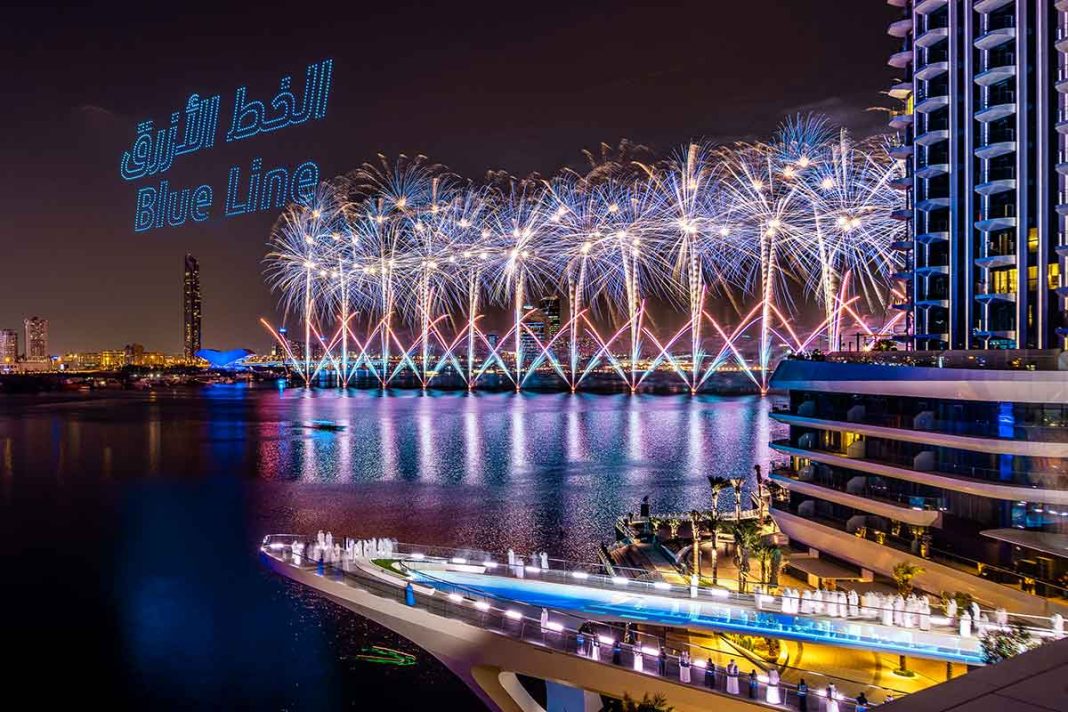Dubai is a city that is expanding constantly, and with this growth comes the need for ever further reaching and more integrated transport infrastructure. The latest project in the Dubai 2040 Urban Master Plan is the expansion of the Dubai Metro, with the launch of the Blue Line. Dubai’s Roads and Transport Authority (RTA) tasked experiential agency, The Hanging House, with producing a fitting celebration to mark the announcement, and the company embarked on a journey to craft an event that would transcend mere celebration.
The event unfolded across four distinct zones, with each offering unique and immersive effects and a seamless, sound-scaped auditory experience running throughout, from the entrance to the grand finale.
In the first zone, The Hanging House creative team reimagined Dubai’s future using a painting brush stroke style and animation on seamless LED screens to create a high-end, immersive entrance. “The narrative commenced with a depiction of Sheikh Rashid driving the Metro, marking the inception of a dream,” recalled The Hanging House’s Creative Lead Luna Arja, explaining the creative. “A multi-dimensional journey unfolded, guided by organic LED presentations and lights embedded in the floor, touching upon the milestones achieved in the construction of the Metro Red and Green Lines over the years.”
In zone two, content agency Real Image crafted a high-quality render, presenting a realistic simulation of the Dubai Metro’s route through the city in a five-minute video, with carefully designed white benches complementing the event’s aesthetics and ensuring the comfort of guests.
The third zone, the immersive room, showcased cutting-edge technology. “Departing from traditional infographic timelines, we utilised LED screens to add depth,” recalled The Hanging House’s Co-Founder and COO Husam Harris. “Animated seawater splashing onto Dubai’s map preceded a detailed exploration of the new Metro’s architecture in a 3D model. The pinnacle of technology in this zone was the activation of the iconic station, employing projection mapping to captivate and entertain our guests.”
The fourth zone and grand finale unfolded on the viewing deck, featuring a spectacular display of fireworks, a mesmerising light show, and a spectacular drone performance to a music specially composed by Mohammed Harib.
SLS Production was engaged by the RTA and The Hanging House to provide audio, video, and lighting for the project. Senior Project Manager Anuj Naik led the project for SLS, alongside HoD Lighting, Praveen Jayakumar, HoD Video, Edgar Pulido, and HoD Audio, Suresh Jayakumar.
The lighting inventory included 100 Ayrton Cobras, 100 Astera Titan Tubes, 48 Robe BMFL WashBeams and 24 ARRI SkyPanels. The video supply meanwhile comprised Absen PL V10 3.9mm and 2.5mm LED at the entrance and opening area, as well as Absen 1.9mm LED, two Panasonic PT-RZ21K projectors, and an Epson EB-PU2116W laser projector in the presentation areas, and seven Panasonic PT-RZ31K projectors to map the bridge area. Content was run through Dataton WATCHOUT and Resolume Arena media servers and a Lightware MX2-16×16-HDMI20 matrix.
The audio deployment included an L-Acoustics Syva system for the entrance area, PreSonus AIR10 speakers for the exhibition area, and JBL systems for the immersive area and drone show audio, with a Yamaha QL5 and DiGiCo SD9 supplied for audio control. A Shure ULXD4Q quad-channel wireless microphone system, DPA Microphones 4288 headset mics and ClearCom FreeSpeak II was also supplied.
“Bringing the client’s vision to reality has been a great pride for us as a production company – especially for a dream project like this,” stated SLS Production’s Account Manager on the project, Theophilus Andrew. “It is a momentous journey for SLS as a production crew; a milestone and one of our thriving success stories.”
‘We accomplished the extraordinary’
With an impressive 2,500 LED drones as well as an arsenal of fireworks deployed, Denis Astakhov, Creative Director for the Drones and Pyro, was a key figure in the production. “While normally we would create the drone formations as visual metaphors of the subject we’re following in the show, here I wanted to try a very literal approach,” he told TPiMEA. “I thought it would be interesting to push the boundaries of the drone technology and to create a full-scale physical representation of a future metro bridge floating just above the water surface. So, I was focusing on how we augment the reality with the drone technology, instead of creative conceptual approach.”
Astakhov praised the Lumasky team for their capabilities and dedication. “Bringing the future Dubai Metro bridge to life using drones was an exhilarating endeavour,” he recalled. “The technology allowed us to artistically recreate a glimpse of the upcoming metro line and the train traversing the canal in the Dubai Creek area. It’s a visionary task that complements our reality seamlessly, offering a tantalising preview of what will soon become a tangible bridge and a fully operational subway train. Working with the Lumasky team and Jean-Marc Chandoo was instrumental in realising this vision, and Dubai, with its dynamic landscape, serves as a perfect canvas for pushing the boundaries of drone show artistry.”
The Creative Director recalled one of his personal highlights of the drone show – the formation of His Highness Sheikh Mohammed bin Rashid Al Maktoum, which featured “almost magically” animated eyes. “What might seem as a small detail and an obvious thing, has required Lumasky to invent the technology and develop the tools necessary to achieve that. And of course we owe our success to the boldness of the agency and the visionary client who allowed us to explore new frontiers in drone show artistry.”
According to Astakhov, what sets this project apart is the unique role of drones in completing the environment. “It’s a rare opportunity where technology doesn’t just enhance but truly becomes an integral part of the surroundings,” he surmised.
Unsurprisingly for such a high-profile performance in a prominent area of Dubai, the project required coordination with several government entities, including the General Civil Aviation Authority, Dubai Civil Aviation Authority, the Ministry of Defense, Dubai Police, and Dubai Maritime Authority. However, according to Denis Kornilovich, Managing Partner and Executive Producer, Lumasky Drone Show, the company’s strong relationships with these authorities ensured that everything was ready and there was ample time for testing and rehearsals prior to the main event.
“Organising a show involving drones, music, lights, and pyrotechnics always presents its challenges, and this time, the complexity was heightened by the unpredictability of the main guest’s arrival,” Kornilovich recalled. “Unlike lights or pyrotechnics, drones require strategic planning due to their flight limitations. We couldn’t afford the risk of the audience being on the observation deck before the show started or, conversely, missing the spectacle altogether. Achieving impeccable timing became our paramount challenge.”
He added: “Through meticulous coordination and leveraging our team’s experience, we achieved a flawless synchronisation of the show’s start precisely when the audience reached the observation deck. This required a unique blend of technical expertise and a keen understanding of timing, essentially predicting the guests’ movements with a level of professionalism that ensured a seamless and captivating experience. It was a delicate dance of technology and timing that, in the end, added an extra layer of magic to the entire event.”
The project’s technicalities involved a strict four-minute time limit for the visible show. “To overcome this, we divided the 2,500 drones into two fleets, ensuring a seamless performance. One fleet of 1,500 drones executed formations of the bridge and the train, while the other of 1,000 was dedicated to showcase the portrait and logos,” Kornilovich described. “We utilised aerial fireworks at varying altitudes, from water surface level to 300m, creating a dynamic cascade. All fireworks were strategically placed on 15 pontoons in the channel, eliminating any interruptions in the show.”
The project was a great source of pride for Kornilovich. “We accomplished the extraordinary – the first animated aerial portrait with drones, the lowest drone flight over water at 7.5m, and the longest drone train at 550m,” he reflected. “The entire show, synchronised with music, lights, and fireworks, featured five formations of the highest quality within time constraints. It’s not just a drone demonstration but a proud display of meaningful storytelling through a spectacular performance.”
With blue selected as the dominant colour across drones, lighting and pyrotechnics, the FLASH ART team devised a fireworks concept that complemented the other show elements. “We knew this would be an interesting project from the very beginning,” recalled Jakub Michalik, Managing Partner, FLASH ART. “It was the number of elements involved, together with the inclusion of the whole neighbourhood in which everyone was instructed to follow the colour scheme discipline, which promised a spectacle to remember.”
While FLASH ART’s brief was to provide a strong presence for a relatively short amount of time among the various other media, according to Michalik, the key to the success of the project was the creative concept, which resulted in a “concise and tasteful, yet dynamic and impressive” show.
“The division of show ‘real estate’ between all the designers, who each needed their own space in three dimensions, provided somewhat of a challenge, and we had to shift our setup around at the pre-production stage,” he recalled. “However, looking at the finished product, we would do it all again and more.”
Photos: FLASH ART, The Hanging House





